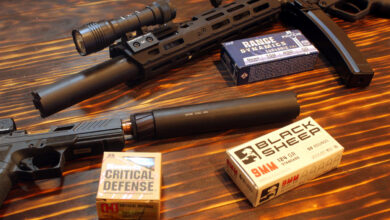.380 ACP in Your 9mm Pistol: Will it work?

Although we infer that there is one universal pistol cartridge called 9mm, we understand it to mean 9mm Luger, 9mm Parabellum, or 9×19. However, 9mm also consists of a whole family of cartridges that are nominally 9mm caliber. The most popular of these is .380 ACP. Although it is called .380, the cartridge uses a .355-inch diameter bullet, like our 9mm does. That begs the question: Can you shoot .380 ACP in your 9mm pistol? I did it, and I highly recommend not doing it. Here is why:
.380 in Your 9mm Pistol: An Ammo History
Both the .380 ACP and the 9mm Luger cartridge were designed as a way to increase the stopping power of existing pistol platforms. Georg Luger developed the 9mm Luger cartridge in 1904. He did this to satisfy the German Army, who wanted something with a bigger bore diameter than the 7.63mm that was adopted by the Swiss in 1900. The 9mm Luger featured a full metal jacketed bullet and a tapered, rimless brass case for reliable feeding. The case measured 19mm in length and housed a nominal 124-grain bullet. The 9mm cartridge is a moderately powerful round and intended for locked-action pistols like the toggle-lock P08 Luger. However, almost all 9mm pistols, both then and now, are locked breech pistols of some kind.
What’s in a name?
The .380 ACP, confusingly enough, was and is called 9mm, depending on where you are. It was originally marketed in Europe as the 9mm Browning and in the US as the .380. At the time, Browning sold competing pistol designs to both FN and Colt. The Model 1908 pistols chambered for the new round were little more than existing .32 caliber pistols belled out for the larger caliber round. It uses a 9mm 95-grain bullet, which is a bit better than a skinnier 71-grain .32 caliber round. Unlike the .32, it was rimless for more reliable feeding. The case length measured 17mm, shorter and straighter than our 9mm Luger round. The .380 is also less powerful. Modern .380 ACP ammunition is rated at a maximum pressure of 21,500 psi, while the 9mm can generate as much as 35,000 psi.
Velocity
Typical 9mm Luger standard pressure loads can hurl a 115-124 grain bullet at 1,100 feet per second, whereas the .380’s lighter 90-100 grain bullet will generally travel at about 900 feet per second. This goes back to the fact that the 9mm was designed for locked breech pistols, while the .380 was made to be the most powerful way to get ammo that would function in a blowback pistol. Now, many .380s pistols are available with a locked breech design, but we still have two popular rounds, nominally 9mm in caliber, so on paper, interchangeable. Right?
Will a .380 Round Fit in a 9mm Pistol?
If you were making barrels on a factory line, the blanks for .380 or 9mm pistols would be the same. Each fires a .355-inch bullet, although the .380, on the whole, is lighter. The .380 is also known in Europe and other parts of the world as 9mm Browning, 9×17, 9mm Corto, or 9mm Kurz. That gives us the impression that the .380 is just a shorter 9mm that should fit in a 9mm pistol, just like a shorter .38 Special cartridge can chamber and fire in a revolver designed for the longer .357 Magnum cartridge. However, the 9mm Luger uses a tapered case that is thicker at the rear than at the front, whereas the .380 has a straight wall case that is the same diameter throughout.

I measured out the case head and mouth diameter of the .380 round at .376 inch. With the 9mm Luger round, the case head starts with a larger diameter of .386 inches and a mouth measuring .376 inches. The rear of the .380 is dimensionally smaller than that of the 9mm. Furthermore, the case is shorter. When placed in a 9mm pistol’s chamber, the .380 has plenty of space to expand at the case head. Since it uses a shorter case, it can’t headspace properly. While the .380 will fit in the magazine of a 9mm pistol and chamber, it is only held in firing position by the extractor. Furthermore, the .380’s smaller diameter case body leaves room in the chamber, which could cause unsafe case expansion. But in the name of science and shooting things, I decided to shoot .380 ammo in my CZ-75 chambered in 9mm.
Shooting Test: .380 in Your 9mm
I loaded three rounds of Aguila 95-grain .380 ACP ammunition in my CZ-75 pistol. There is plenty of dead space in the magazine with the rounds pushed to the rear. I racked the slide, and the first round was picked up by the slide and chambered as if it were made for this pistol. I fired the pistol into my range’s berm from a sideways position so I could catch the brass casing and potentially avoid blowback.

Bang-No-Bang
Pulling the trigger proved anticlimactic. The round fired, but the pistol failed to cycle fully. The .380 ammo did not have the power to forcefully run the slide rearward to kick the empty case out. The case was stove-piped while the next round underneath it chambered. The same thing happened for the next two rounds. While you could fire .380 in your 9mm, don’t expect it to be reliable. But on examination of the spent cases, it can also be dangerous.
The cases of the .380 rounds were bulged from the case mouth to the case head, which somehow managed to hold its shape. The skinnier case body tried to form itself into the larger 9mm chamber. While I feared the cases would split and potentially send brass shards out in any direction, none of the ammunition failed in such a way. But the cases were darkened on one side, indicating gas escaping in the chamber.

While I felt no gas blowback in this test, it is possible in other circumstances. But at minimum, gas loss could impede power. How much so? I decided to fire two more rounds over my Caldwell Chronograph. Each round had a muzzle velocity of 649 and 624 feet per second. Considering this same ammunition clocks in at over 850 feet per second out of my shorter-barreled Ruger LCP, you are giving up both power and reliability at the very least by rigging .380 ACP ammo into your 9mm pistol.
Conclusion
I came away from my little test unscathed and with my very first malfunctions from my CZ-75. It could have been worse if I had to do it in an emergency. Using .380 ACP ammo in your 9mm handgun is possible. It will fire and send a bullet down the barrel. But you lose what little power .380 has, give up reliability, and put yourself and any bystanders in avoidable danger. Don’t try this for yourself.
The post .380 ACP in Your 9mm Pistol: Will it work? appeared first on The Mag Life.
Read the full article here






